Bitcoin
Mt. Gox Moves Another $2 Billion In Bitcoin, How Much Is Left?

The defunct crypto exchange Mt. Gox isn’t done with its Bitcoin repayments to creditors, as on-chain data shows that the exchange recently moved a significant amount of BTC. This has raised the question of how much Bitcoin Mt. Gox has left, considering the negative impact these BTC repayments have had on the flagship crypto’s price action so far.
Mt. Gox’s $2 Billion BTC On The Move
The on-chain analytics platform Arkham Intelligence revealed in an X (formerly Twitter) post that a wallet (bc1q26) that had received $2.19 billion worth of Bitcoin from Mt. Gox had recently initiated test transactions. This development is significant as the wallet that received the 33,105 BTC ($2.19 billion) from Mt. Gox is believed to belong to Bitgo, the fifth and final exchange the trustee approved for the BTC repayments.
As such, Bitgo may be preparing to distribute these Bitcoins to creditors. Following the test transaction, Bitgo moved Mt. Gox’s $2 billion BTC to another wallet (bc1qpn5), which could be a security precaution before they begin repayments to creditors. These Bitcoin transfers are also believed to be related to creditor repayments because some users on a Mt. Gox Reddit channel recently claimed they received BTC in their Bitgo account.
Mt. Gox’s Bitcoin repayments began last month, spreading panic through the crypto market as BTC dropped to as low as $54,000. These BTC distributions raised concerns that Mt. Gox creditors may sell off their BTC once received, which would put significant selling pressure on the flagship crypto.
However, the on-chain analytics platform Cryptoquant revealed that these Mt. Gox creditors chose to hold rather than offload their BTC holdings. Cryptoquant cited a spike in withdrawals from Kraken following the Mt. Gox Bitcoin repayments through the exchange, which suggests that these creditors were moving their coins to cold wallets.
This explains why Bitcoin remained steady despite the recent Mt. Gox BTC transfers. However, the defunct crypto exchange still holds 46,164 BTC ($2.81 billion), which could still significantly impact the market depending on whether other creditors choose to hold.
Bitcoin Awaits Critical Inflation Report
Bitcoin has continued to trade sideways as investors await the July Consumer Price Index (CPI) inflation report, which will be released on August 14. A positive inflation reading would strengthen the case for the US Federal Reserve to cut rates in September, boosting investors’ confidence in risk assets like Bitcoin and other cryptocurrencies.
The July Producer Price Index (PPI) inflation report, released on August 13, was positive, coming in lower than expectations. As such, a positive CPI inflation report might be all the confirmation that the Fed needs that inflation has indeed slowed and that now is the perfect time for the rate cuts. Following the August 5 Bitcoin crash, Bernstein analysts predicted that Bitcon’s price would turn bullish again when the Fed cuts interest rates.
Featured image created with Dall.E, chart from Tradingview.com
Bitcoin
Vitalik’s L2 Roadmap, XRP Unlock and More

This week in crypto, a lot happened across different ecosystems, despite the broader market’s prevailing bearish sentiment. Besides Bitcoin’s (BTC) drop to a 7-day low of $81,400, here are this week’s biggest updates.
For starters, crypto markets could have a new Ethereum Layer-2 roadmap. Meanwhile, Hyperliquid users could soon start enjoying better security.
Vitalik Buterin Pushes for Ethereum L2 Roadmap
Co-founder Vitalik Buterin outlined a roadmap for Ethereum’s Layer-2 (L2) ecosystem, emphasizing decentralization, security, and cost-efficiency.
He advocates for a model that reduces centralization risks while ensuring user-friendly experiences for developers and investors.
Buterin also reiterated his commitment to open-source funding within the Ethereum community. This stance comes as the phrase “public goods” has become politically and socially loaded. The phrase is often used in ways that prioritize perception over impact.
Against this backdrop, Buterin proposed shifting the focus from “public goods funding” to “open-source funding.” He said this would encourage greater financial support for projects that enhance network security and scalability.
“A big part of the reason why the term ‘public good’ is vulnerable to social gaming is precisely the fact that the definition of ‘public good’ is stretched so easily,” Buterin argued.
His vision aligns with ongoing efforts to strengthen Ethereum’s L2 playing field and make it more resistant to potential censorship or network failures.
Hyperliquid Tightens Security After JELLY Crisis
Decentralized trading platform Hyperliquid also features among the key headlines this week in crypto. The platform announced new security measures following the JELLY incident, which resulted in substantial losses for users.
To prevent future incidents, the platform has increased monitoring, enhanced smart contract audits, and introduced stricter withdrawal limits.
Hyperliquid’s response aims to restore confidence in decentralized finance (DeFi) platforms amid rising security concerns.
“Hyperliquid is not perfect, but it will continue to iterate and grow through the collective efforts of builders, traders, and supporters,” the network explained.
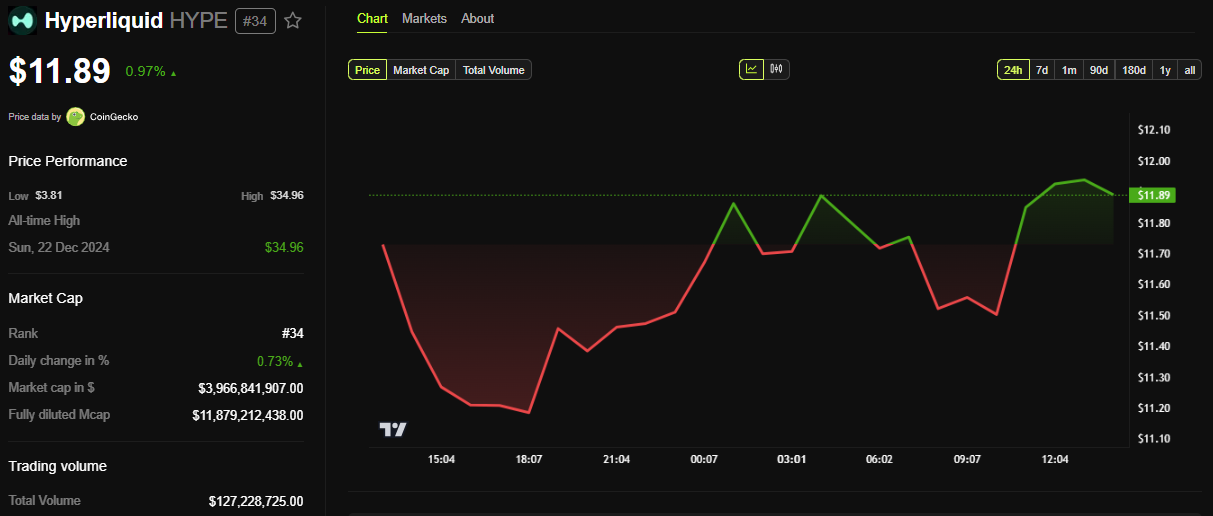
BeInCrypto data shows that Hyperliquid’s HYPE token price was $11.89 as of this writing, up by a modest 0.97% in the last 24 hours.
Crypto Markets, Equities Sync Amid Recession Fears
Another headline this week in crypto was how the digital assets industry continues to mirror traditional financial (TradFi). Specifically, more than ever, the crypto market appears synchronized with indices like the S&P 500 and Nasdaq.
The synchrony comes as investors react to growing recession concerns. Bitcoin and Ethereum have followed similar downturns seen in stock markets, reinforcing the argument that cryptocurrencies are increasingly correlated with broader economic conditions.
With macroeconomic uncertainty looming, analysts warn that crypto could further decline if economic conditions worsen. However, some argue long-term investors may find opportunities in current market lows.
According to former BitMEX CEO Arthur Hayes, Bitcoin could reach $250,000 by year-end. However, this forecast is contingent on the Federal Reserve (Fed) shifting to Quantitative Easing (QE) to support markets.
Meanwhile, former Goldman Sachs executive Raoul Pal pointed to macroeconomic indicators that suggest a Bitcoin rally is imminent. He shared a chart correlating the global M2 money supply and Bitcoin’s price.
Based on history, Bitcoin tends to rise around 10 weeks after M2 increases. Pal’s analysis suggests that Bitcoin may soon enter a bullish phase.
“The waiting game is almost over…the 10-week lead is my preferred… but,” Pal stated.
Ripple Unlocked $1 Billion in XRP
Also, this week in crypto, Ripple released another 1 billion XRP from its escrow, increasing selling pressure on the token.
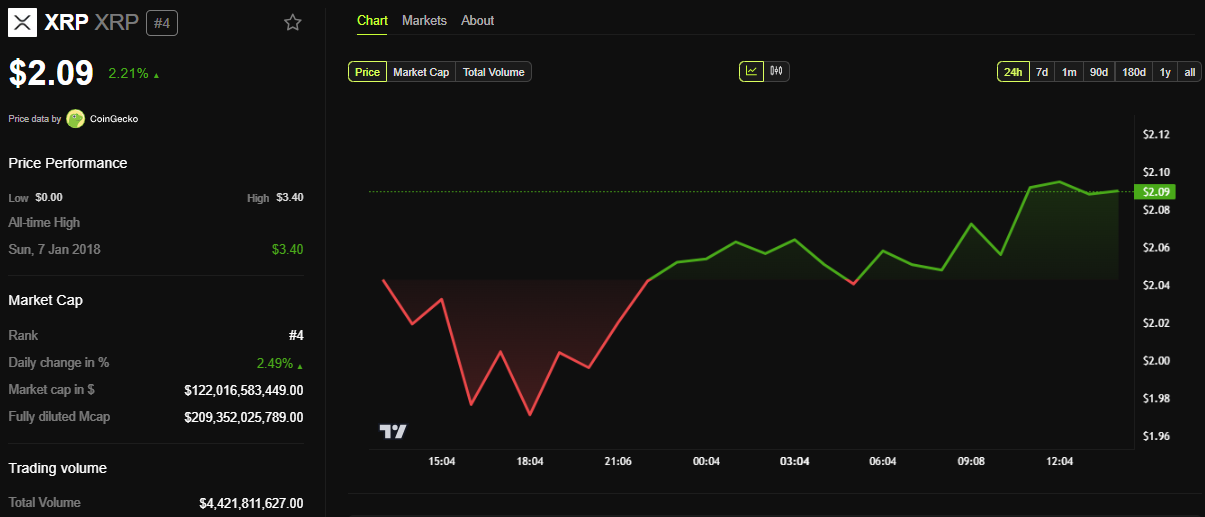
Historically, such unlocks have been followed by price declines. This aligns with recent Keyrock research that showed that 90% of unlocks create negative price pressure.
The tokens were moved from the “Ripple (27)” escrow address to two operational wallets, “Ripple (12)” and “Ripple (13).” This suggested the intention to distribute or sell XRP.
Investors remain cautious, watching for signs of potential accumulation. Meanwhile, others anticipate further downside as XRP struggles to regain upward momentum amid broader market uncertainty.
Notwithstanding, there are other positive developments for the XRP market. According to Glassnode data, Retail investors are choosing XRP over Bitcoin, and nearly half of XRP’s realized cap is increasing.
Another bullish fundamental for XRP this week is Coinbase’s filing for a futures contract offering in the Ripple token. The move indicates shifting regulatory tides in the US and also bolsters XRP ETF (exchange-traded funds) approval odds.
Standard Chartered Predicts Crypto Winners
Standard Chartered also made it to the top headlines this week in crypto. The bank identified Bitcoin (BTC) and Avalanche (AVAX) as the primary beneficiaries of a potential post-Liberation Day crypto market surge.
The bank suggests that favorable macroeconomic conditions and increasing institutional adoption could propel these assets higher in the coming months.
“We expect volatility to edge gradually lower once the ETF market matures, increasing Bitcoin’s share of an optimal gold-BTC portfolio. Access plus lower volatility could see Bitcoin reach the $500,000 level before Trump leaves office,” wrote Geoff Kendrick, Head of Digital Asset Research at Standard Chartered, in an email to BeInCrypto.
This forecast aligns with the growing narrative that institutional interest will play a key role in shaping the next phase of the crypto market cycle. However, skeptics remain cautious, citing regulatory uncertainty and potential economic headwinds as factors that could delay or dampen such a rally.
Disclaimer
In adherence to the Trust Project guidelines, BeInCrypto is committed to unbiased, transparent reporting. This news article aims to provide accurate, timely information. However, readers are advised to verify facts independently and consult with a professional before making any decisions based on this content. Please note that our Terms and Conditions, Privacy Policy, and Disclaimers have been updated.
Bitcoin
Why Bitcoin Is Gaining Appeal Amid Falling US Treasury Yields

The US 10-year Treasury yield has fallen below 4% for the first time since October.
This signals a potential shift in Federal Reserve (Fed) policy, sparking renewed interest in Bitcoin (BTC) and other risk assets.
Treasury Yields and Bitcoin: A Risk-On Rotation?
As highlighted by financial markets aggregator Barchart, this decline reflects growing economic uncertainty. Specifically, it suggests rising recession fears and increasing speculation that the Fed may pivot to rate cuts sooner than expected.
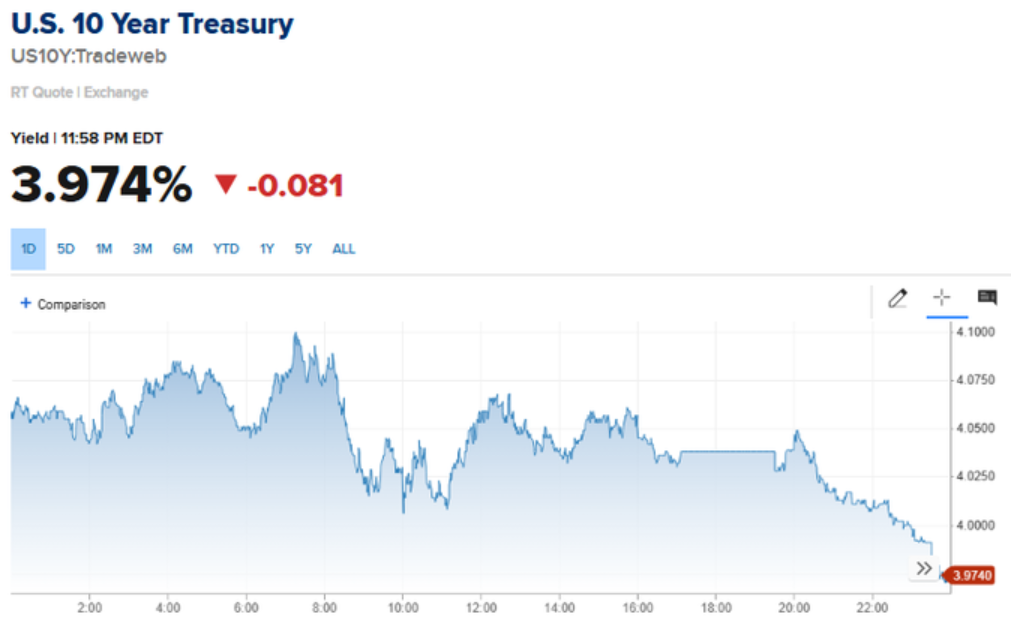
A drop in Treasury yields reduces the attractiveness of traditional safe-haven assets like bonds, often encouraging investors to seek higher returns elsewhere.
Historically, Bitcoin and altcoins have benefitted from such shifts, as declining real yields increase liquidity and risk appetite. Crypto analyst Dan Gambardello emphasized this connection. He noted that lower yields are bullish for Bitcoin, aligning with expectations that a dovish Fed will drive liquidity into riskier assets.
“The irony is that when yields fall, there’s less reason to sit in “safe” bonds— And ultimately more reason to chase returns in risk assets like BTC and alts. This is why you see risk-on bulls get excited when 10-year yields begin falling,” he stated.
Additionally, BitMEX founder and former CEO Arthur Hayes pointed out that the 2-year Treasury yield sharply declined after the new tariffs were introduced. He said this reinforced the market’s expectation of imminent Fed rate cuts.
“We need Fed easing, the 2yr treasury yield dumped after Tariff announcement because the market is telling us the Fed will be cutting soon and possibly restarting QE to counter -ve economic impact,” Hayes shared on X (Twitter).
Hayes previously projected that Bitcoin could surge as high as $250,000 if quantitative easing (QE) returns in response to economic downturns.
The Trump Factor: Tariffs and Market Volatility
Further, analysts have tied the yield drop to economic uncertainty triggered by Trump’s aggressive tariff strategy. As Gambardello noted, these tariffs have spurred a flight to safety, pushing bond prices higher and lowering yields.
This trend aligns with Trump’s broader economic approach of weakening the dollar and lowering interest rates, which historically benefit Bitcoin. During his first term, Trump frequently desired a weaker dollar and lower interest rates to boost exports and economic growth. He also pressured the Fed to cut rates multiple times.
Another analyst, Kristoffer Kepin, highlighted that the M2 money supply is growing. This reinforces expectations of increased liquidity entering the market further. This influx of capital could flow into Bitcoin and altcoins as investors seek alternative stores of value amid economic turbulence.
Despite Bitcoin’s potential upside, Goldman Sachs has recommended gold and the Japanese yen as preferred hedges against US recession risks. Specifically, the bank cited its historical performance in risk-off environments.
“The yen offers investors the best currency hedge should the chances of a US recession increase,” Bloomberg reported, citing Kamakshya Trivedi, head of global foreign exchange, interest rates, and emerging market strategy at Goldman Sachs.
The bank expressed the same sentiment toward gold, raising its forecast as investors buy the yellow metal. Similarly, a Bank of America (BofA) survey showed that 58% of fund managers prefer gold as a trade war haven, while only 3% back Bitcoin.
Meanwhile, JPMorgan has raised its global recession probability to 60%. Likewise, the multinational banking and financial services company attributed the increased risk to the economic shock from tariffs announced on Liberation Day.
“These policies, if sustained, would likely push the US and possibly global economy into recession this year,” wrote head of global economic research Bruce Kasman in a note late Thursday.
However, Kasman acknowledged that while a scenario where the rest of the world muddles through a US recession is possible, it is less likely than a global downturn.
As Treasury yields continue to fall and economic uncertainty mounts, the Fed becomes a key watch for investors for signs of a policy shift.
If rate cuts and liquidity injections materialize, Bitcoin could see substantial gains, particularly as traditional assets undergo re-pricing. However, as experts caution, short-term volatility remains a key risk factor amidst these market shifts.
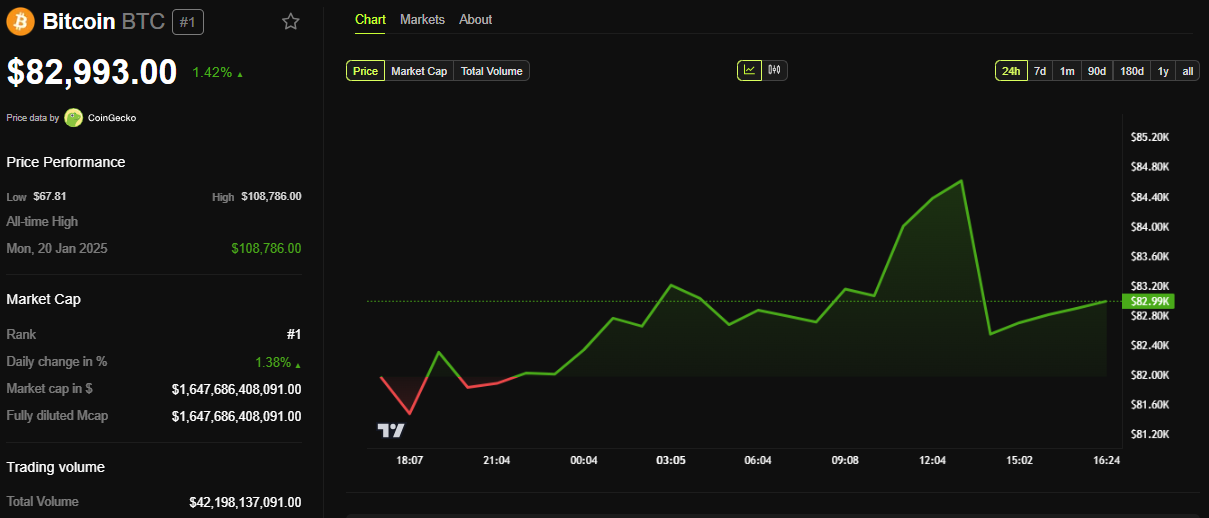
BeInCrypto data shows Bitcoin was trading for $82,993 as of this writing, up by a modest 1.42% in the last 24 hours.
Disclaimer
In adherence to the Trust Project guidelines, BeInCrypto is committed to unbiased, transparent reporting. This news article aims to provide accurate, timely information. However, readers are advised to verify facts independently and consult with a professional before making any decisions based on this content. Please note that our Terms and Conditions, Privacy Policy, and Disclaimers have been updated.
Bitcoin
Bitcoin Drops as China Escalates Trade War With 34% Tariff on US

On April 4, 2025, China responded to the latest US tariff imposition by imposing an additional 34% tariff on all goods imported from the US. This escalates the already tense trade war between the two largest economies in the world.
Bitcoin dropped 3% within hours of the announcement, briefly falling below $82,000. This latest development has caused concern among investors, analysts, and participants in the cryptocurrency sector about its potential impact.
Bitcoin Investors Worry About The Escalating Trade War
According to Xinhua News Agency, China will impose a 34% tariff on all products imported from the US starting April 10. Xinhua reported that the US’s “Reciprocal Tariff” violated WTO rules, severely damaging the legal and legitimate rights of WTO members and undermining the multilateral trade system and the international trade order based on rules.
“This is a typical act of unilateral hegemony that harms the stability of the global economic and trade order. China firmly opposes this,” The spokesperson for the Ministry of Commerce said in an interview about China’s lawsuit against the US’s “Reciprocal Tariff” at the WTO.
Previously, President Trump had imposed a 34% tariff on China in addition to the 20% tariffs already imposed in two phases. This means a total of 54% tariffs were applied to China.
News from China has caused concern among crypto investors. On April 4, Bitcoin’s price dropped from $84,600 to $82,000, a 3% decrease.
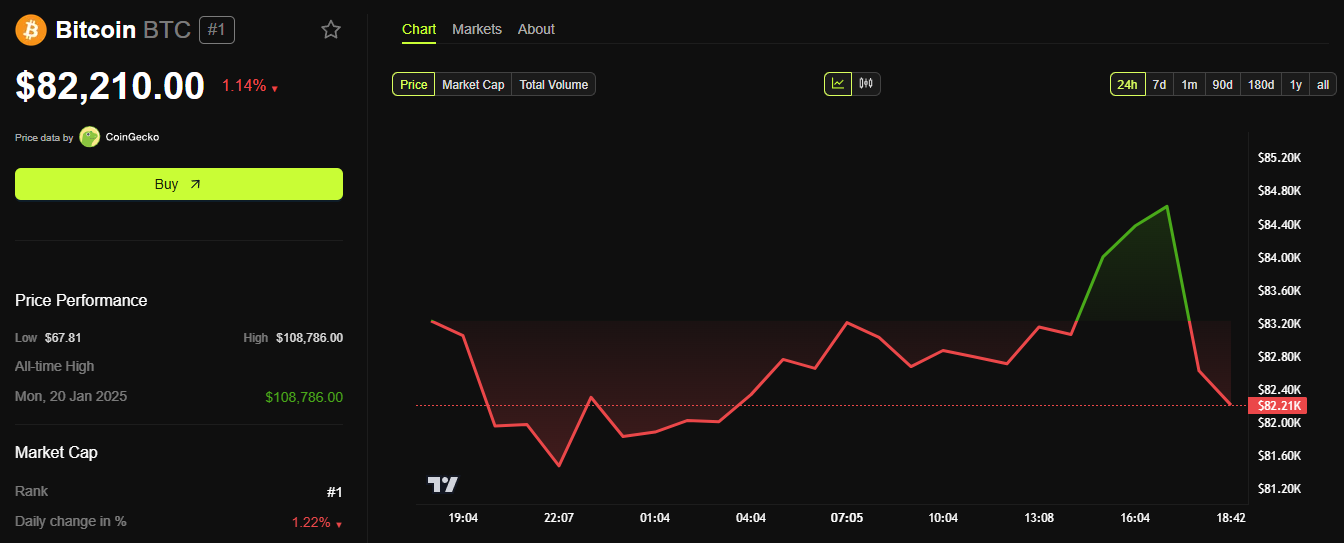
At the same time, following the news, the Long/Short ratio of Bitcoin dropped below 1, indicating a growing sentiment for short-selling, which has become dominant in the market.

Both Bitcoin and other markets have been affected. The S&P 500 fell from 5,260 points to 5,250 points, while the Dow Jones Industrial Average dropped from 41,100 points to 40,500 points. China’s actions have raised concerns about the potential escalation of the global trade war.
“The ‘Third World War’ of the trade war has begun,” The Kobeissi Letter commented.
What Will Happen to Bitcoin When The US-China Trade War Escalates?
This cryptocurrency, often praised as a hedge against economic instability, tends to behave like a risky asset during sudden uncertain periods. Historical patterns support this reaction—during the US-China trade war in 2018-2019, Bitcoin experienced significant sell-offs as tariffs escalated, only recovering when the narrative of value preservation took precedence.
A significant portion of the global cryptocurrency hardware supply chain comes from China, where companies like Bitmain dominate the production of ASIC mining machines—important devices for Bitcoin mining.
With the US now facing a 34% tariff on technology imports from China, the cost of importing these mining machines is expected to rise dramatically. Bitcoin miners in the US, already facing high energy costs and competitive pressure on hashrate, may see their profits shrink further.
However, the long-term outlook for Bitcoin may not be as bleak as the initial market reaction. Some analysts suggest that prolonged trade wars and economic friction could enhance Bitcoin’s appeal as a decentralized asset unaffected by government intervention. If tariffs lead to inflation or weaken fiat currencies like the USD, investors may turn to cryptocurrencies as a safe haven.
“It’s not gold, and it’s not the yen. Instead, Bitcoin is emerging as a risk-dynamic asset – one that doesn’t crumble like high-growth stocks but also doesn’t attract the same flight-to-safety flows as traditional safe havens,” Nexo Dispatch Editor Stella Zlatarev told BeInCrypto.
This sentiment aligns with research indicating that instability often causes initial price drops but can pave the way for growth as acceptance increases.
Disclaimer
In adherence to the Trust Project guidelines, BeInCrypto is committed to unbiased, transparent reporting. This news article aims to provide accurate, timely information. However, readers are advised to verify facts independently and consult with a professional before making any decisions based on this content. Please note that our Terms and Conditions, Privacy Policy, and Disclaimers have been updated.
-

 Market23 hours ago
Market23 hours agoWormhole (W) Jumps 10%—But Is a Pullback Coming?
-

 Altcoin23 hours ago
Altcoin23 hours agoAltcoin Season Still In Sight Even As Ethereum Struggles To Gain Upward Momentum
-

 Market22 hours ago
Market22 hours agoBinance’s CZ is Helping Kyrgyzstan Become A Crypto Hub
-

 Ethereum17 hours ago
Ethereum17 hours agoEthereum Faces ‘Hyperinflation Hellscape’—Analyst Reveals Key On-Chain Insights
-

 Market17 hours ago
Market17 hours agoWhat to Expect After March’s Struggles
-

 Altcoin22 hours ago
Altcoin22 hours agoHere’s Why Is Shiba Inu Price Crashing Daily?
-

 Market21 hours ago
Market21 hours agoCrypto Market Mirrors Nasdaq and S&P 500 Amid Recession Fears
-

 Altcoin21 hours ago
Altcoin21 hours agoExpert Reveals XRP Price Could Drop To $1.90 Before Rally To New Highs

























